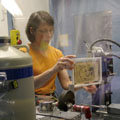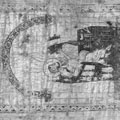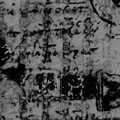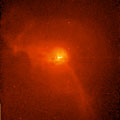An overview of the Chandra mission and goals, Chandra's namesake, top 10 facts.
Classroom activities, printable materials, interactive games & more.
Overview of X-ray Astronomy and X-ray sources: black holes to galaxy clusters.
All Chandra images released to the public listed by date & by category
Current Chandra press releases, status reports, interviews & biographies.
A collection of multimedia, illustrations & animations, a glossary, FAQ & more.
A collection of illustrations, animations and video.
Chandra discoveries in an audio/video format.
X-Ray Fluorescence Reveals the Hidden Secrets of Black Holes and Ancient Manuscripts
June 13, 2005 ::
 |
Abigail Quandt, head of book and paper conservation at The Walters Art Museum, slides a framed page of the Archimedes parchment into a holder that moves in front of the x-ray beam like a book being read by a stationary eye.
(Photo by Diana Rogers)
|
The ability of X-rays to travel through the dust and gas around black holes enables astronomers to investigate many properties of these mysterious objects. Chandra observations of X-ray fluorescence from iron atoms in the gas and dust have revealed how black holes warp space, how fast the black holes are
spinning, and the rate of
creation of iron atoms over the history of the Universe.
| Fluorescence Illustrated |

Schematic of X-ray fluorescence
|
|
X-ray fluorescence from iron atoms occurs when a high energy X-ray knocks an electron free from the innermost energy level of an iron atom, creating an unstable atom. An electron from an outer energy level immediately jumps into a lower energy state, with the emission of an X-ray with a distinct energy specific to iron. Around black holes this happens when high-energy X-rays produced by hot gas very near the black hole collide with cooler gas and dust in the vicinity.
|

Illustration of Black Hole with Accretion Disk and Torus
|
|
Now, researchers at Stanford University are using X-ray fluorescence to investigate a mystery much closer to home - a hidden manuscript of the genius Archimedes, born 287 B.C. in Syracuse, Sicily.
 |
A photograph of one page of the Archimedes Palimpsest. Visible and UV light cannot see Archimedes' text under the gold painting done by a 20th Century forger. The text is oriented sideways like this when scanned.
(Image provided by Will Noel, The Walters Art Museum)
|
Archimedes is widely credited with being the greatest scientist and mathematician of ancient times. He calculated a highly accurate value of the ratio of the circumference to the diameter of a circle (pi) using methods that were not fully developed until Newton and Leibniz invented calculus about 2,000 years later.
Upon discovering the principle of the lever, Archimedes is said to have remarked, "Give me a fixed point, and I can move the world." When challenged by the King of Sicily, Archimedes reportedly designed an elaborate system of pulleys that enabled him to pull a ship ashore singlehandedly. Archimedes later invented giant claws that would lift ships out of the water. These were used to defend Syracuse against invaders.
| The Principle of "Mechanical Advantage"
|
|
This principle says that a small force exerted over a long distance can move a large object a short distance. Thus, with a rigid lever and a stable fulcrum point, exerting a force of ten pounds with a lever arm of 10 feet will lift a 100-pound object positioned one foot on the other side of the fulcrum. The same principle is used in pulley systems to lift heavy objects by pulling a rope or chain a long distance.
|
|
Perhaps the most famous saying of Archimedes is "Eureka!". The fact that he said it while he was supposedly running down the street naked probably had something to do with people remembering it.
As the story goes, the king had given Archimedes the task of determining whether a crown was really pure gold, or if the goldsmith had cheated by using a little silver, which has a lower density. Archimedes knew that he had to measure the volume of the crown to solve the problem, but because of the highly irregular shape of the crown, he couldn't determine the volume. Then one day, when stepping into a full bath tub, he noted that the water overflowed by an amount equal in volume to that portion of his body that was under water.
Archimedes immediately knew that he had the solution to the problem posed by the king. Without waiting to put on his clothes, he dashed into the street shouting "Eureka!" or "I've found it!" He had discovered the principle of buoyancy.
 |
X-ray fluorescence imaging at Stanford Linear Accelerator Center revealed the hidden text. This x-ray image shows the lower left corner of the page.
(Image provided by Will Noel, The Walters Art Museum)
|
By immersing the crown in the water, and measuring the amount of water that overflowed, Archimedes (presumably fully dressed by now) was able to determine the volume of the crown. When he compared this volume to that of a gold bar that weighed the same as the crown, he found that the crown was not pure gold. The King thanked Archimedes and executed the goldsmith.
By working out the principles of the lever, of buoyancy, and other mechanical theorems, Archimedes laid the foundation for the science of mechanics some 1800 years later when the translation of his works into Latin inspired Galileo to do his famous experiments.
| Principle of Buoyancy and Galactic Explosions
|

|
|
Archimedes' principle of buoyancy can be stated as: An immersed body is buoyed up by a force equal to the weight of the fluid it displaces. It is true of liquids and gases, which are both fluids. One consequence of this principle is that a bubble of low density fluid will rise through a higher density fluid, as in bubbles of water vapor in a pan of boiling water. This effect probably explains the enormous bubble-like structures seen in several Chandra images of galaxy clusters. A magnetized cloud of high-energy particles may be created by explosive activity in the vicinity of a supermassive black hole. The buoyancy force will cause this low-density cloud to rise through the higher-density hot cluster gas, and expand to produce the observed bubbles that have diameters of hundreds of thousands of light years.
|
|
Archimedes' ideas have been lost and found several times throughout the ages. Now scientists are using X-ray fluorescence at the Stanford Linear Accelerator Center to completely read the Archimedes Palimpsest, the only source for at least two previously unknown 3rd Century B.C. treatises by Archimedes.
The palimpsest is a 1,000-year-old parchment made of goat skin containing Archimedes' work as laboriously copied down by a 10th century scribe. Two centuries later, with parchment hard to come by, the ink was erased with a weak acid (like lemon juice) and scraped off with a pumice stone. Then, the parchment was written on again to make a prayer book. To make matters worse, four pages were painted over with Byzantine religious images, which turned out to be 20th Century forgeries intended to increase the value of the prayer book.
Deciphering the original ink on the parchment was proving to be an intractable problem until scientist Uwe Bergmann at Stanford University had his own Eureka moment. When he learned the original manuscript ink contained iron pigment, he realized that they could use the synchrotron X-ray generator at Stanford to make the ink fluoresce.
Extra ink in one spot causes a more intense signal. Generally, the ink from the Archimedes text is no more than a faint stain in the fibers of the parchment, while the thicker, un-erased ink of religious text sits on its surface. Where the two overlap (the texts are written perpendicular to each other) the iron signal is stronger, which may allow researchers to separate the two texts.
Archimedes' hidden text deals with floating bodies and the equilibrium of planes.
Another page contains an introduction to the only copy of Archimedes' Method of Mechanical Theorems, where Archimedes showed how he arrived at his theorems.
An anonymous private collector who bought the palimpsest for $2 million at auction in 1998 has loaned the manuscript to the Walters Art Museum in Baltimore, Maryland, and is funding the studies. Researchers come from Stanford, RB Toth Associates, Rochester Institute of Technology, Johns Hopkins University, Conoco Phillips and Rutgers University. The team plans to decipher the entire original text, catalog and transcribe it digitally, and create an interactive DVD. They will then exhibit a few pages in 2008 before returning the irreplaceable parchment to its owner.
For more information, see:
http://www.thewalters.org
and
http://www-ssrl.slac.stanford.edu/










